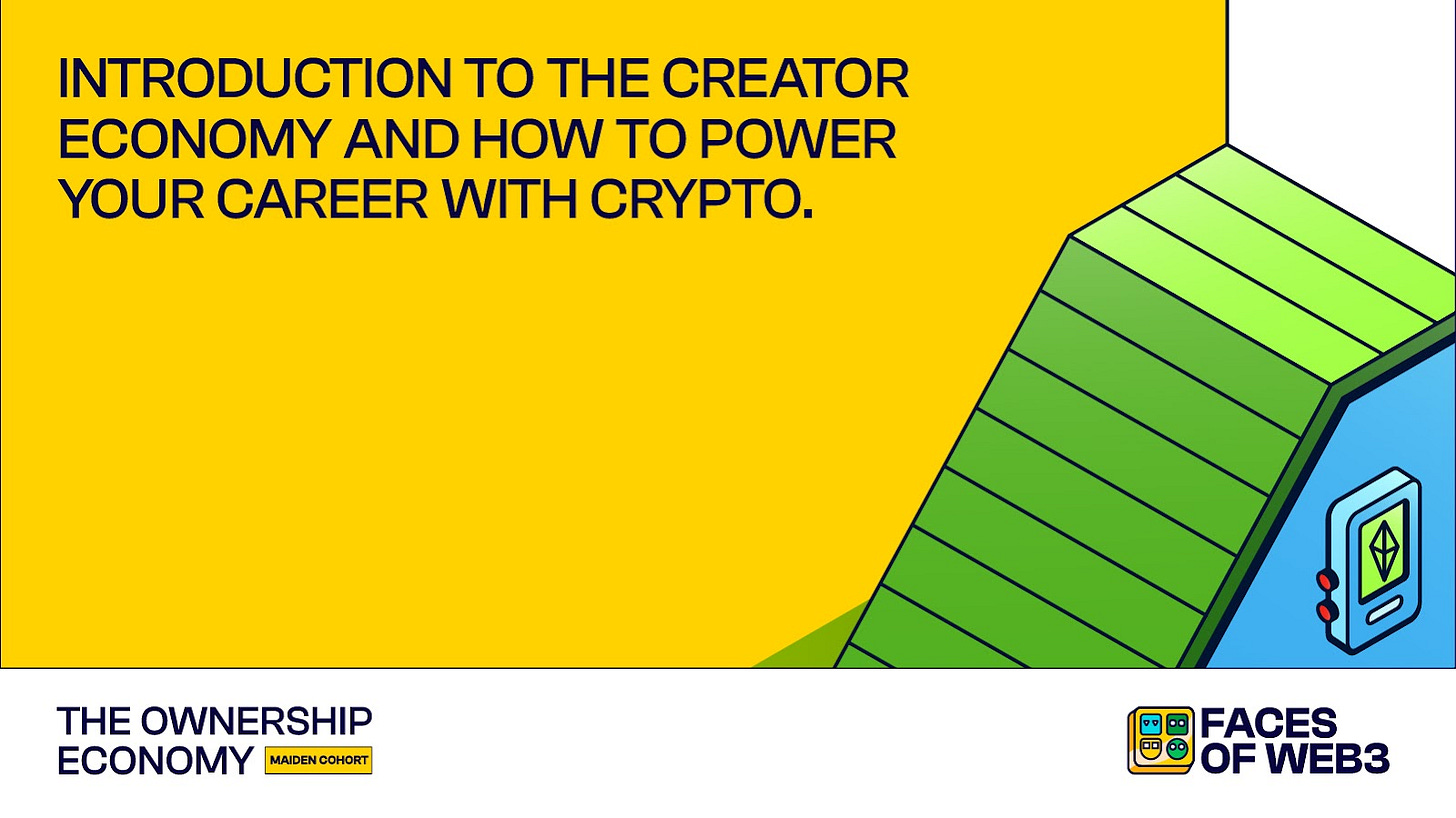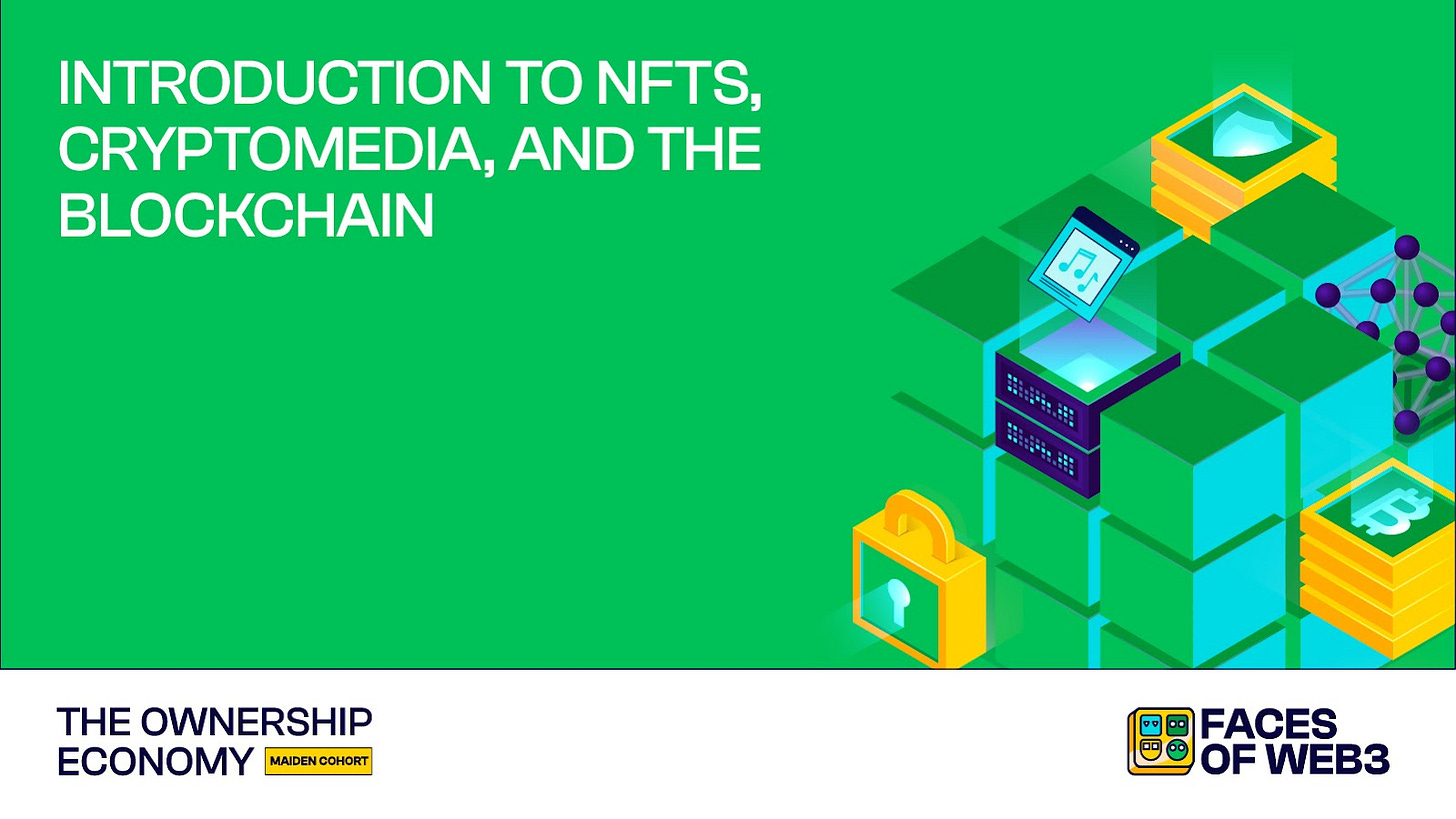Course Roundup: Introduction to the Creator Economy.
A recap before your saturday decaf ☕
Hello Creator!
Thanks for taking the ownership economy cohort with Facesofweb3!
Course 1 (Introduction to the creator economy) took us on a journey into the creator economy and how to power your career with cryptocurrency. Here’s a recap summarizing what we’ve learned in the last few weeks as we prepare for the second course.
We’ve also added some assignments to help guide you through the key points as you become a full-fledged web3 creator.
Thanks again for sticking with us and welcome to December! 💛
Powering your career as a creator
The world is increasingly becoming digital, and you can purchase anything from meals to houses over the internet.
The first module in this course, titled Introduction to the Creator Economy and how to Power your Career with Crypto, offered us a glimpse into the Creator Economy while providing intermediate knowledge about different aspects of the Web3 space. We discussed the creator and passion economy, the progression of the internet to Web3, and how creators can benefit from the ecosystem.
The rise of user-generated content has given birth to what we now call the creator economy, a community of independent creators or curators who utilise digital platforms to share their work and earn a living. Platforms, creators, and fans work together in this economy to create value.
The ownership economy, often called Web3, combines products and services that turn users into owners and make consumers active participants. The ownership economy strengthens the bond between creators and their communities; when creators receive donations, sell merchandise and enable subscription fees, they can reward their fans.
There are three main types of ownership in Web3: Tokens, Decentralized Autonomous Organizations, and non-fungible tokens. Web3 enables creators to build and co-own their creations with their fans and monetise them directly without third-party interference.
Web3 is transforming the creator economy and allowing more creators to scale, reach a wider audience, and control their assets better. In this module, we learned the main differences between Web1 and Web2, what the creator economy is, how Web2 led to the rise of the creator economy, and the different types of ownership in Web3.
Assignment:
How have you utilized web2 platforms so far?
How can you optimize web3 for your work?
Decentralized Finance and its benefits to creators
In the second module, we looked deeper into Decentralised Finance, blockchain technology, and how they benefit creators. We also took a quick look at some of the challenges Web2 creators face and how DeFi tools empower content creators in the Web3 space.
Although Web3 is still in its infancy, it offers users various technologies, from artificial intelligence to cryptocurrencies. In addition, it is transforming the content economy from the traditional system to a more decentralised and inclusive marketplace.
Web2 content creators face significant challenges like content piracy, high cost of operation, and limited channels for monetization of their work. In addition, although centralised platforms rely on them to drive traffic and build active audiences for advertisers using engaging content, they retain excessive revenue. This makes creators feel under-represented, unrecognised, and often undervalued for their work.
Blockchain technology is an ideal ecosystem that helps content creators track, efficiently monetise, and maintain complete control over their content. It brings a higher level of security, transparency, and traceability to the content industry, and we can create decentralised and transparent records of legitimate owners and their content.
It empowers content creators through anti-piracy of content, transparent revenue sharing, payment of royalties, creative funding, and the facilitation of micropayments.
Many decentralised tools empower content creators in the Web3 space today, including Content Box, SoCool, STEEMit, Binded, and Mycelia.
We also learned essential terms associated with blockchain technology, like decentralisation, decentralised finance, cryptocurrency, metadata, smart contracts, and NFTs.
Even on their best days, the alternatives available to creators for monetization right now are troublesome in the dysfunctional digital ecosystem of today. Compared to the centralized platforms they currently compete with, decentralized communities can provide direct relationships with audiences, better reward strategies, and fairer governance systems.
Assignment:
How can Decentralized financial systems and tools benefit creators?
NFTs and Cryptomedia
In the next module, the Introduction to NFTs and Cryptomedia, we looked into Non-Fungible Tokens (NFTs) and Cryptomedia, explored the different types and categories and went over different related concepts, directions on how to explore each of them in more detail if you choose, real-world use cases, benefits, drawbacks, and how you can get started as a digital creator.
NFT (pronounced “en-ef-tee”) means non-fungible token. When an item is fungible, you can trade or swap it for something similar without losing any value in the exchange. Some fungible items are bitcoin, dollar bills, stocks, and commodities.
Non-fungible assets are unique and cannot be replaced by anything else or broken up and sold in pieces because the whole item determines the value. Examples of non-fungible assets include diamonds, one-of-a-kind trading cards, real estate property, family heirlooms, art collectibles, and non-fungible tokens.
NFTs are unique digital assets stored on the blockchain. When you mint an NFT, you simply upload it to the blockchain. Each NFT has a unique identifier which contains information about that NFT, like who created it, who owns it, and its price history. No two NFTs are precisely alike, and each holds value based on the item's rarity, the community driving it, and more.
Cryptomedia is an umbrella term for digital assets/media. It builds on the concept of cryptocurrency and subsumes a piece of media that is cryptographically secure. Cryptomedia is a medium for anyone on the internet to create universally accessible and individually ownable hypermedia.
Anything can be an NFT if it can be stored on the blockchain. Though NFTs are known mainly in relation to digital art, there’s so much more they cover, and they have an endless number of potential applications, from real estate to online gaming. An NFT can be an artwork, music, video game asset, virtual land, a meme, event ticket, domain name, virtual clothing, event ticket, or (as in the case of Jack Dorsey) a tweet.
Some categories of NFTs include Avatars and PFPs (picture for proof), Collectibles, 1/1 NFTs (pronounced “one of one”), which are single-asset NFTs, and more.
Assignment
What are examples of NFTs that you know?
How would you launch your NFT project?
DAOs
In this course's fourth and final module, we took a quick dip into the world of Decentralised Autonomous Organisations (DAOs), the different types, and why they’re all significant.
Decentralised Autonomous Organisations are internet-native ways people come together to organise and work towards a shared mission. They’re also communities where members have the power to make decisions and oversee a shared treasury and the operation and implementation of such day-to-day activities.
You do not need programming skills or technical knowledge before you start contributing to a DAO. DAOs are increasingly in need of creators to help bring ideas to life. So, whether you’re a web developer, content creator, YouTuber, digital artist, or community builder, there's a dire need for your skills and creativity in DAOs. All you need is a sense of curiosity, a willingness to learn while executing, and an ownership mentality.
As a creator, DAOs can potentially offer you the freedom to carve your path and do what you love in Web3 and a chance to work in a collaborative yet fast-paced environment.
Group organisation and coordination is one of the most significant and recurring themes in solving major local and global issues. DAOs present us with the tools to come together, deliberate on problems, and provide solutions to them transparently and inclusively. They fundamentally solve coordination and profit-sharing problems. Small groups can also form DAOs to launch an album, a comic book collection, or a series of short films.
There are currently over 225 DAOs listed on the List of DAOs, (a directory for DAOs), each of which has its mission and focus. A DAO can choose to focus on education, venture funding, or philanthropy, depending on its mission and goals. There are at least eight types of DAOs, including protocol, grant, media, service, and venture DAOs.
Assignment
In your own words, how would you describe a DAO?
Do you think everyone should form a DAO? Under what circumstances should a DAO not be formed?
Send in the answers to your assignment via pdf to hello@facesofweb3.com
What’s next?
In the next course, we dive deeper into the creator economy, NFTs, and DAOs and explore how you can better benefit from the tools Web3 offers.
The course is titled Participating in the Creator Economy. It focuses on blockchain wallets, minting NFTs, and creating better opportunities through DAOs.
• Module 1: Wallets and Wallet addresses (Types of blockchain and the wallets you can use to interact with them)
• Module 2: How to become an NFT creator: Marketplaces and steps to minting your own NFTs
• Module 3: How you can create space for your skills in DAOs
• Module 4: An in-depth look into the work and journey of a DAO contributor




